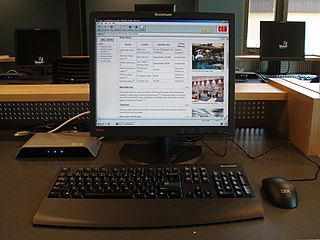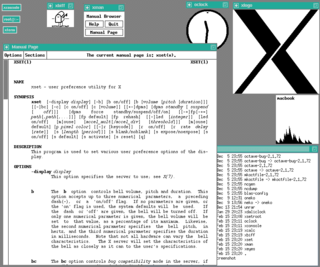
Malware is any software intentionally designed to cause disruption to a computer, server, client, or computer network, leak private information, gain unauthorized access to information or systems, deprive access to information, or which unknowingly interferes with the user's computer security and privacy. Researchers tend to classify malware into one or more sub-types.

Spyware is software with malicious behaviour that aims to gather information about a person or organization and send it to another entity in a way that harms the user—for example, by violating their privacy or endangering their device's security. This behaviour may be present in malware as well as in legitimate software. Websites may engage in spyware behaviours like web tracking. Hardware devices may also be affected. Spyware is frequently associated with advertising and involves many of the same issues. Because these behaviors are so common, and can have non-harmful uses, providing a precise definition of spyware is a difficult task.

In computer networking, a thin client is a simple (low-performance) computer that has been optimized for establishing a remote connection with a server-based computing environment. They are sometimes known as network computers, or in their simplest form as zero clients. The server does most of the work, which can include launching software programs, performing calculations, and storing data. This contrasts with a rich client or a conventional personal computer; the former is also intended for working in a client–server model but has significant local processing power, while the latter aims to perform its function mostly locally.

Back Orifice 2000 is a computer program designed for remote system administration. It enables a user to control a computer running the Microsoft Windows operating system from a remote location. The name is a pun on Microsoft BackOffice Server software.
Installation of a computer program, is the act of making the program ready for execution. Installation refers to the particular configuration of software or hardware with a view to making it usable with the computer. A soft or digital copy of the piece of software (program) is needed to install it. There are different processes of installing a piece of software (program). Because the process varies for each program and each computer, programs often come with an installer, a specialised program responsible for doing whatever is needed for the installation. Installation may be part of a larger software deployment process.
Remote Desktop Protocol (RDP) is a proprietary protocol developed by Microsoft Corporation which provides a user with a graphical interface to connect to another computer over a network connection. The user employs RDP client software for this purpose, while the other computer must run RDP server software.

Scareware is a form of malware which uses social engineering to cause shock, anxiety, or the perception of a threat in order to manipulate users into buying unwanted software. Scareware is part of a class of malicious software that includes rogue security software, ransomware and other scam software that tricks users into believing their computer is infected with a virus, then suggests that they download and pay for fake antivirus software to remove it. Usually the virus is fictional and the software is non-functional or malware itself. According to the Anti-Phishing Working Group, the number of scareware packages in circulation rose from 2,850 to 9,287 in the second half of 2008. In the first half of 2009, the APWG identified a 585% increase in scareware programs.
End-to-end encryption (E2EE) is a private communication system, only communicating users can participate, no adversary nor eavesdropper can interfere, not the communication system provider, telecom providers, Internet providers, nor malicious actors, only communicating users can access the cryptographic keys needed to converse.
Remote administration refers to any method of controlling a computer from a remote location. Software that allows remote administration is becoming increasingly common and is often used when it is difficult or impractical to be physically near a system in order to use it. A remote location may refer to a computer in the next room or one on the other side of the world. It may also refer to both legal and illegal remote administration.

In computing, a shell is a computer program that exposes an operating system's services to a human user or other programs. In general, operating system shells use either a command-line interface (CLI) or graphical user interface (GUI), depending on a computer's role and particular operation. It is named a shell because it is the outermost layer around the operating system.
Mobile malware is malicious software that targets mobile phones or wireless-enabled Personal digital assistants (PDA), by causing the collapse of the system and loss or leakage of confidential information. As wireless phones and PDA networks have become more and more common and have grown in complexity, it has become increasingly difficult to ensure their safety and security against electronic attacks in the form of viruses or other malware.
Defensive computing is a form of practice for computer users to help reduce the risk of computing problems, by avoiding dangerous computing practices. The primary goal of this method of computing is to be able to anticipate and prepare for potentially problematic situations prior to their occurrence, despite any adverse conditions of a computer system or any mistakes made by other users. This can be achieved through adherence to a variety of general guidelines, as well as the practice of specific computing techniques.

In computing, the term remote desktop refers to a software- or operating system feature that allows a personal computer's desktop environment to be run remotely off of one system, while being displayed on a separate client device. Remote desktop applications have varying features. Some allow attaching to an existing user's session and "remote controlling", either displaying the remote control session or blanking the screen. Taking over a desktop remotely is a form of remote administration.
This page is a comparison of notable remote desktop software available for various platforms.

VirusTotal is a website created by the Spanish security company Hispasec Sistemas. Launched in June 2004, it was acquired by Google in September 2012. The company's ownership switched in January 2018 to Chronicle, a subsidiary of Google.
The end node problem arises when individual computers are used for sensitive work and/or temporarily become part of a trusted, well-managed network/cloud and then are used for more risky activities and/or join untrusted networks. End nodes often are not managed to the trusted network‘s high computer security standards. End nodes often have weak/outdated software, weak security tools, excessive permissions, mis-configurations, questionable content and apps, and covert exploitations. Cross contamination and unauthorized release of data from within a computer system becomes the problem.

Mobile security, or mobile device security, is the protection of smartphones, tablets, and laptops from threats associated with wireless computing. It has become increasingly important in mobile computing. The security of personal and business information now stored on smartphones is of particular concern.
AnyDesk is a remote desktop application distributed by AnyDesk Software GmbH. The proprietary software program provides platform independent remote access to personal computers and other devices running the host application. It offers remote control, file transfer, and VPN functionality. AnyDesk is often used in technical support scams and other remote access scams.
Browser isolation is a cybersecurity model which aims to physically isolate an internet user's browsing activity away from their local networks and infrastructure. Browser isolation technologies approach this model in different ways, but they all seek to achieve the same goal, effective isolation of the web browser and a user's browsing activity as a method of securing web browsers from browser-based security exploits, as well as web-borne threats such as ransomware and other malware. When a browser isolation technology is delivered to its customers as a cloud hosted service, this is known as remote browser isolation (RBI), a model which enables organizations to deploy a browser isolation solution to their users without managing the associated server infrastructure. There are also client side approaches to browser isolation, based on client-side hypervisors, which do not depend on servers in order to isolate their users browsing activity and the associated risks, instead the activity is virtually isolated on the local host machine. Client-side solutions break the security through physical isolation model, but they do allow the user to avoid the server overhead costs associated with remote browser isolation solutions.
Government hacking permits the exploitation of vulnerabilities in electronic products, especially software, to gain remote access to information of interest. This information allows government investigators to monitor user activity and interfere with device operation. Government attacks on security may include malware and encryption backdoors. The National Security Agency's PRISM program and Ethiopia's use of FinSpy are notable examples.




